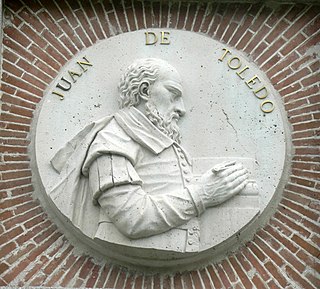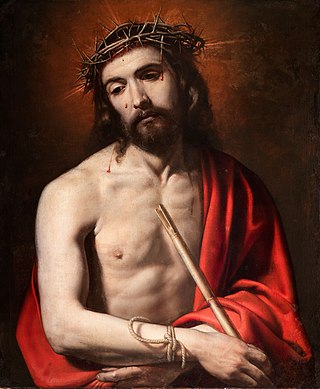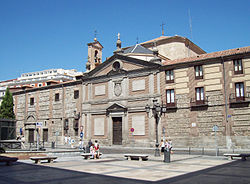
Poblet Abbey, otherwise the Royal Abbey of Santa Maria de Poblet, is a Cistercian monastery, founded in 1151, located at the foot of the Prades Mountains, in the comarca of Conca de Barberà, in Catalonia (Spain). It was founded by Cistercian monks from France. The main architect was Arnau Bargués.

Tourism in Spain is a major contributor to national economic life, contributing to about 12.4% of Spain's GDP. Ever since the 1960s and 1970s, the country has been a popular destination for summer holidays, especially with large numbers of tourists from the United Kingdom, Ireland, France, Germany, Italy, the Benelux, and the United States, among others. Accordingly, Spain's foreign tourist industry has grown into the second-biggest in the world.

El Escorial, or the Royal Site of San Lorenzo de El Escorial, or Monasterio de El Escorial, is a historical residence of the king of Spain located in the town of San Lorenzo de El Escorial, 2.06 kilometres (1.28 mi) up the valley from the town of El Escorial and about 45 kilometres (28 mi) northwest of the Spanish capital Madrid. Built between 1563 and 1584 by order of King Philip II, El Escorial is the largest Renaissance building in the world. It is one of the Spanish royal sites and functions as a monastery, basilica, royal palace, pantheon, library, museum, university, school, and hospital.

The Royal Sites are a set of palaces, monasteries, and convents built for and under the patronage of the Spanish monarchy. They are administered by Patrimonio Nacional (National Heritage), a Spanish state agency; most are open to the public, at least in part, except when they are needed for state or official events.

Gaspar Becerra (1520–1568) was a Spanish painter and sculptor of the School of Valladolid.

Juan Bautista de Toledo was a Spanish architect. He was educated in Italy, in the Italian High Renaissance. As many Italian renaissance architects, he had experience in both architecture and military and civil public works. Born, either in Toledo or in Madrid around 1515. He died on 19 May 1567 in Madrid, and was buried in Madrid in the choir of the primitive “Convento de Santo Tomás, Iglesia de la Santa Cruz”.

Patrimonio Nacional is a Spanish autonomous agency, under the jurisdiction of the Ministry of the Presidency, Justice and Relations with the Cortes, that administers the sites owned by the Spanish State and used by the Monarch and the Spanish Royal Family as residences and for State Ceremonies. The Patrimonio Nacional includes palaces, gardens, monasteries and convents, called the Royal sites. When not in official use, the Royal sites are open to the public. It also manages the official and holiday residences of the Prime Minister.

The Abbey of Santa María la Real de Las Huelgas is a monastery of Cistercian nuns located approximately 1.5 km west of the city of Burgos in Spain. The word huelgas, which usually refers to "labour strikes" in modern Spanish, refers in this case to land which had been left fallow. Historically, the monastery has been the site of many weddings of royal families, both foreign and Spanish, including that of Edward I of England to Eleanor of Castile in 1254, for example. The defensive tower of the abbey is also the birthplace of King Peter of Castile.

Antonio Fernández Arias was a Spanish painter of the Baroque period.

The Real Monasterio de la Encarnación is a convent of the order of Recollet Augustines located in Madrid, Spain. The institution mainly interned women from noble families, and was founded by the Queen Margaret of Austria, wife of Philip III, and thus was well endowed with wealth. Although it belongs to an enclosed religious order, the building is open to the public under the administration of the Patrimonio Nacional.

The Monasterio de las Descalzas Reales is a monastery located in Valladolid, in Castile and León, Spain. Literally the Monastery of the Barefoot Royals, the name refers to the practice of the usage of the Colettine branch of the Order of St. Clare to be barefoot while within the cloister. This monastery is to be distinguished from a similarly named one in Madrid of the same Order.

Sobrado Abbey, is a Cistercian monastery in the province of La Coruña, Galicia, Spain. It is situated in the municipality of Sobrado, about 9 km east of Corredoiras and about 46 km southeast of Betanzos, at an altitude of 540 m above sea level.
The Flemish chapel was one of two choirs employed by Philip II of Spain, the other being the Spanish chapel. Deriving from the Grand Chapelle of Philip I of Castile, the choir served under various forms until the reign of Charles II of Spain.
Monasteries in Spain have a rich artistic and cultural tradition, and serve as testament to Spain's religious history and political-military history, from the Visigothic Period to the Middle Ages. The monasteries played an important role in the recruitment conducted by Christian aristocracy during and after the progress of the Reconquista, with the consequent decline in the Muslim south of the peninsula.
The Royal Household and Heritage of the Crown of Spain was the institution of the Monarchy of Spain. It governed the organization of the Royal Spanish Court from the time of the Habsburg dynasty, which introduced the so-called Burgundian etiquette, up to the reign of King Alfonso XIII, great-grandfather of the current King Felipe VI, in all that regarded the structure of the Court as well as the ceremonial matters, etiquette and protocol.
Matías Juan de Veana was a Spanish composer. He was chapelmaster both at the Real Monasterio de la Encarnación and at the Monasterio de las Descalzas Reales in Madrid, and became known for his villancicos.

The Arrabal of Saint Martin was a medieval arrabal (neighborhood) that sat outside the Christian Walls of Madrid. It was located around the location of the current Plaza of San Martín, and occupied the space between Calle del Arenal, the Plaza de las Descalzas, Plaza del Callao, and Calle de las Navas de Tolosa. It grew as a population center around the Monastery of Saint Martin, neighboring San Martín was the Arrabal of San Ginés, and both were absorbed by the growth of the city in the 17th century.

Isabella Borgia Enriquez was an Italian-Spanish noblewoman, religious and writer, daughter of Juan Borgia, II Duke of Gandia, illegitimate son of Pope Alexander VI, and Maria Enriquez de Luna.



















